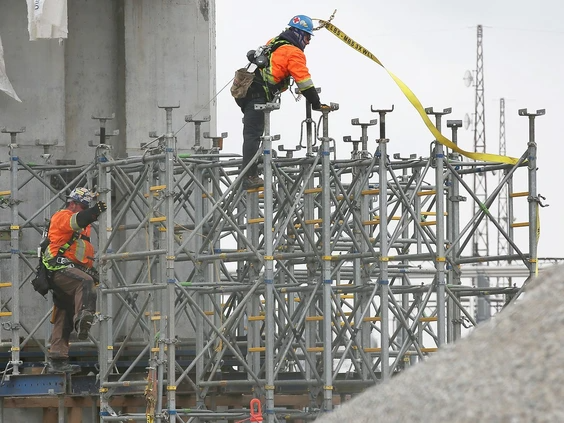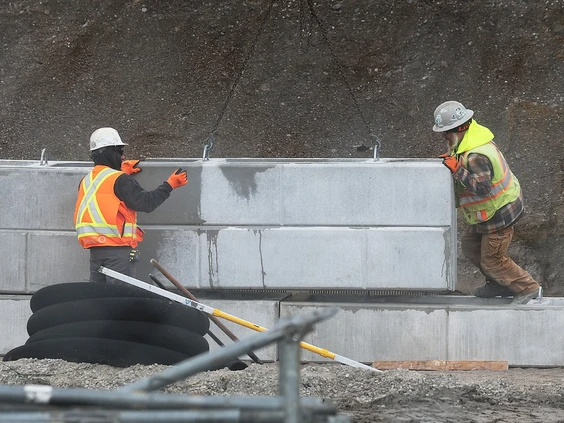Windsor’s economic outlook goes from worst to most promising

Workers are shown at the Gordie Howe International Bridge construction site in Windsor on March 29, 2023. PHOTO BY DAN JANISSE /Windsor Star
With massive new investments underway or on the horizon, the Windsor area may be enjoying the start of a renaissance in its fortunes, but a new study shows the depth of the economic hole the region is climbing out of.
The Fraser Institute, a public policy think tank, looked at economic performance in southwestern Ontario from 2005 to 2019, a period in which the Windsor region’s median income fell 7.1 per cent, dropping it from 11th place in Canada to 33rd.
“What the study showed was a period for Ontario broadly of lower growth than other provinces, but the pain wasn’t shared evenly,” said the report’s co-author Ben Eisen, a senior fellow with the Fraser Institute.
“Southwestern Ontario had some of the lowest income growth in the entire country. People really struggled in the region.
“It was one of the most prosperous areas in the country, and it dropped into the lower third of the rankings.”
In 2019, the Windsor area’s median wage was $57,840, while London’s was $59,510.
The Windsor census metropolitan area, which also includes Lakeshore, Tecumseh, LaSalle and Amherstburg, was one of only two areas in Canada to see a drop in median income. The other region was, surprisingly, the technology hub of Kitchener-Waterloo and Cambridge, which experienced a drop of 1.3 per cent.
London also fell dramatically in the median income rankings, from 13th to 28th, as Ontario was the worst-performing province in Canada, according to the Fraser Institute’s research. Ontario experienced a five-per-cent increase in median income compared to the national average of 11.1 per cent.Eisen said there were some distinct differences in how Ontario’s tepid recovery from the Great Recession of 2008-09 played out.
Communities that were closer to the Greater Toronto Area fared better as did the provincial capital itself.“For Windsor, manufacturing was a very important factor in what happened,” Eisen said. “There were challenges with jobs disappearing in the manufacturing sector before 2008.”
Manufacturing jobs in the Windsor CMA peaked in 2006 at 42,900, and by 2010 the sector had shrunk to 28,700 with the closing of GM’s Windsor transmission plant and other companies leaving for lower-cost locales.
Windsor-Essex Regional Chamber of Commerce CEO Rakesh Naidu said the study is a historical snapshot of a challenging time for Windsor.
“The auto industry has taken time to recover from the 2008 recession and some plants and suppliers never came back,” Naidu said. “The auto industry also was transformed with tiered pay grids and lower wages.”

Jobs, incomes and the local economy are on an upswing. Workers are shown at the Gordie Howe International Bridge construction site on March 29, 2023. PHOTO BY DAN JANISSE /Windsor Star
Naidu added local median income levels are also impacted by retirees and young families moving to the area because of its affordability.
Between 2006 and 2022, the number of retirees (65-plus) living in the area grew from 41,900 to 73,400, or by 75 per cent.
“Retirees’ incomes are lower and young families are just building their income levels,” Naidu said.
“Windsor is also a popular destination for new immigrants and refugees, which is good and needed for the long term, but it takes time for people to get on their feet. I’m an example because I came here with two suitcases and didn’t make a lot to start.”
Naidu added the study also doesn’t reflect what’s happening in Windsor now, especially in the automotive and construction industries and with a steadily growing population.
The Conference Board of Canada is forecasting the Windsor CMA will enjoy the highest GDP growth in Canada this year at 2.4 per cent, which is 12 times the predicted provincial growth and nearly double the national growth. The region is also expected to outpace the provincial and national gains in 2024.
Workforce WindsorEssex CEO Justin Falconer calls the pace and extent of the Windsor CMA’s recovery remarkable. The area has added 26,000 jobs since September.
“The growth in the number of employed people in the past six months is greater than it’s been for the past 15 years,” Falconer said.
“From 2006 to 2019 we added 10,400 employed persons. The growth is shocking and there are still many job postings each month.
“We have hit 190,000 employed persons in the Windsor CMA. That’s the highest number ever.”
Leading the revival are the area’s manufacturing and construction industries.
Statistics Canada’s January Labour Force Survey reported the region was once again pushing record levels of manufacturing jobs with 40,600. In February, there were 39,100 people employed in the sector.
Workers are also enjoying higher wages.
Statistics Canada reported the average wage for the Windsor-Sarnia-Chatham area in the fourth quarter of 2022 was 11.1 per cent higher compared to the fourth quarter of 2021.
Though still below the provincial ($68,350) and national ($66,230) numbers in the latest median income figures available from Statistics Canada (2020), the Windsor CMA’s median has risen to $63,070.
“We’ve got momentum and I only seeing it building in the next few years,” Naidu said.
“The fight for talent is only going to become more fierce. I think we’ll see a different picture on incomes over the next five years.”




